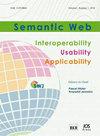知识图谱嵌入方法的 RDF2vec 系列
IF 3
3区 计算机科学
Q2 COMPUTER SCIENCE, ARTIFICIAL INTELLIGENCE
引用次数: 1
摘要
知识图谱嵌入是一组机器学习技术,可将知识图谱的实体和关系投射到连续向量空间。RDF2vec 是一种可扩展的嵌入方法,根植于随机行走与语言模型的结合。它已成功应用于多种领域。最近,人们提出了 RDF2vec 方法的多种变体,在随机游走生成和语言建模方面都引入了变化。这些不同方法的组合导致 RDF2vec 变体的数量不断增加。在本文中,我们在一组全面的基准模型上评估了总共十二种 RDF2vec 变体,并将它们与链接预测方法系列中的七种现有知识图嵌入方法进行了比较。除了在 DBpedia 知识图谱上引入各种下游机器学习任务的 GEval 基准外,我们还使用了新的 DLCC(描述逻辑类构造函数)基准,该基准由两个黄金标准组成,一个基于 DBpedia,另一个基于合成生成的图谱。后者可以分析知识图谱中哪些本体模式可以通过不同的嵌入学习到。通过这项评估,我们观察到,考虑到基础问题的性质,某些定制的 RDF2vec 变体可以在不同的下游任务中提高性能,尤其是在相似性和相关性建模方面有不同的表现。这些发现可为特定任务选择特定的 RDF2vec 方法提供指导。本文章由计算机程序翻译,如有差异,请以英文原文为准。
The RDF2vec family of knowledge graph embedding methods
Knowledge graph embeddings represent a group of machine learning techniques which project entities and relations of a knowledge graph to continuous vector spaces. RDF2vec is a scalable embedding approach rooted in the combination of random walks with a language model. It has been successfully used in various applications. Recently, multiple variants to the RDF2vec approach have been proposed, introducing variations both on the walk generation and on the language modeling side. The combination of those different approaches has lead to an increasing family of RDF2vec variants. In this paper, we evaluate a total of twelve RDF2vec variants on a comprehensive set of benchmark models, and compare them to seven existing knowledge graph embedding methods from the family of link prediction approaches. Besides the established GEval benchmark introducing various downstream machine learning tasks on the DBpedia knowledge graph, we also use the new DLCC (Description Logic Class Constructors) benchmark consisting of two gold standards, one based on DBpedia, and one based on synthetically generated graphs. The latter allows for analyzing which ontological patterns in a knowledge graph can actually be learned by different embedding. With this evaluation, we observe that certain tailored RDF2vec variants can lead to improved performance on different downstream tasks, given the nature of the underlying problem, and that they, in particular, have a different behavior in modeling similarity and relatedness. The findings can be used to provide guidance in selecting a particular RDF2vec method for a given task.
求助全文
通过发布文献求助,成功后即可免费获取论文全文。
去求助
来源期刊

Semantic Web
COMPUTER SCIENCE, ARTIFICIAL INTELLIGENCEC-COMPUTER SCIENCE, INFORMATION SYSTEMS
CiteScore
8.30
自引率
6.70%
发文量
68
期刊介绍:
The journal Semantic Web – Interoperability, Usability, Applicability brings together researchers from various fields which share the vision and need for more effective and meaningful ways to share information across agents and services on the future internet and elsewhere. As such, Semantic Web technologies shall support the seamless integration of data, on-the-fly composition and interoperation of Web services, as well as more intuitive search engines. The semantics – or meaning – of information, however, cannot be defined without a context, which makes personalization, trust, and provenance core topics for Semantic Web research. New retrieval paradigms, user interfaces, and visualization techniques have to unleash the power of the Semantic Web and at the same time hide its complexity from the user. Based on this vision, the journal welcomes contributions ranging from theoretical and foundational research over methods and tools to descriptions of concrete ontologies and applications in all areas. We especially welcome papers which add a social, spatial, and temporal dimension to Semantic Web research, as well as application-oriented papers making use of formal semantics.
 求助内容:
求助内容: 应助结果提醒方式:
应助结果提醒方式:


